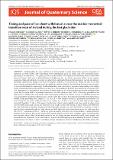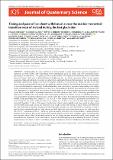Files in this item
Timing and pace of ice-sheet withdrawal across the marine–terrestrial transition west of Ireland during the last glaciation
Item metadata
| dc.contributor.author | Ó Cofaigh, Colm | |
| dc.contributor.author | Callard, S. Louise | |
| dc.contributor.author | Roberts, David H. | |
| dc.contributor.author | Chiverrell, Richard C. | |
| dc.contributor.author | Ballantyne, C. K. | |
| dc.contributor.author | Evans, David J. A. | |
| dc.contributor.author | Saher, Margot | |
| dc.contributor.author | Van Landeghem, Katrien J. J. | |
| dc.contributor.author | Smedley, Rachel | |
| dc.contributor.author | Benetti, Sara | |
| dc.contributor.author | Burke, Matthew | |
| dc.contributor.author | Clark, Chris D. | |
| dc.contributor.author | Duller, Geoff A. T. | |
| dc.contributor.author | Fabel, Derek | |
| dc.contributor.author | Livingstone, Stephen J. | |
| dc.contributor.author | Mccarron, Stephen | |
| dc.contributor.author | Medialdea, Alicia | |
| dc.contributor.author | Moreton, Steven G. | |
| dc.contributor.author | Sacchetti, Fabio | |
| dc.date.accessioned | 2021-04-08T15:30:10Z | |
| dc.date.available | 2021-04-08T15:30:10Z | |
| dc.date.issued | 2021-04-07 | |
| dc.identifier | 273717682 | |
| dc.identifier | 56461ef1-ba17-41f2-8994-b0b463c4803b | |
| dc.identifier | 85103673662 | |
| dc.identifier | 000637473400001 | |
| dc.identifier.citation | Ó Cofaigh , C , Callard , S L , Roberts , D H , Chiverrell , R C , Ballantyne , C K , Evans , D J A , Saher , M , Van Landeghem , K J J , Smedley , R , Benetti , S , Burke , M , Clark , C D , Duller , G A T , Fabel , D , Livingstone , S J , Mccarron , S , Medialdea , A , Moreton , S G & Sacchetti , F 2021 , ' Timing and pace of ice-sheet withdrawal across the marine–terrestrial transition west of Ireland during the last glaciation ' , Journal of Quaternary Science , vol. Early View . https://doi.org/10.1002/jqs.3295 | en |
| dc.identifier.issn | 0267-8179 | |
| dc.identifier.other | RIS: urn:951128EAD935442A3EFCB63B878C1789 | |
| dc.identifier.uri | https://hdl.handle.net/10023/22990 | |
| dc.description | This research was funded by the UK Natural Environment Research Council grant NE/J007196/1 ‘Britice‐Chrono’. The work was supported by the NERC Radiocarbon Facility (Allocation No. 1722.0613 and 1878.1014). | en |
| dc.description.abstract | Understanding the pace and drivers of marine‐based ice‐sheet retreat relies upon the integration of numerical ice‐sheet models with observations from contemporary polar ice sheets and well‐constrained palaeo‐glaciological reconstructions. This paper provides a reconstruction of the retreat of the last British–Irish Ice Sheet (BIIS) from the Atlantic shelf west of Ireland during and following the Last Glacial Maximum (LGM). It uses marine‐geophysical data and sediment cores dated by radiocarbon, combined with terrestrial cosmogenic nuclide and optically stimulated luminescence dating of onshore ice‐marginal landforms, to reconstruct the timing and rate of ice‐sheet retreat from the continental shelf and across the adjoining coastline of Ireland, thus including the switch from a marine‐ to a terrestrially‐based ice‐sheet margin. Seafloor bathymetric data in the form of moraines and grounding‐zone wedges on the continental shelf record an extensive ice sheet west of Ireland during the LGM which advanced to the outer shelf. This interpretation is supported by the presence of dated subglacial tills and overridden glacimarine sediments from across the Porcupine Bank, a westwards extension of the Irish continental shelf. The ice sheet was grounded on the outer shelf at ~26.8 ka cal bp with initial retreat underway by 25.9 ka cal bp. Retreat was not a continuous process but was punctuated by marginal oscillations until ~24.3 ka cal bp. The ice sheet thereafter retreated to the mid‐shelf where it formed a large grounding‐zone complex at ~23.7 ka cal bp. This retreat occurred in a glacimarine environment. The Aran Islands on the inner continental shelf were ice‐free by ~19.5 ka bp and the ice sheet had become largely terrestrially based by 17.3 ka bp. This suggests that the Aran Islands acted to stabilize and slow overall ice‐sheet retreat once the BIIS margin had reached the inner shelf. Our results constrain the timing of initial retreat of the BIIS from the outer shelf west of Ireland to the period of minimum global eustatic sea level. Initial retreat was driven, at least in part, by glacio‐isostatically induced, high relative sea level. Net rates of ice‐sheet retreat across the shelf were slow (62–19 m a−1) and reduced (8 m a−1) as the ice sheet vacated the inner shelf and moved onshore. A picture therefore emerges of an extensive BIIS on the Atlantic shelf west of Ireland, in which early, oscillatory retreat was followed by slow episodic retreat which decelerated further as the ice margin became terrestrially based. More broadly, this demonstrates the importance of localized controls, in particular bed topography, on modulating the retreat of marine‐based sectors of ice sheets. | |
| dc.format.extent | 28 | |
| dc.format.extent | 9866476 | |
| dc.format.extent | 9872105 | |
| dc.language.iso | eng | |
| dc.relation.ispartof | Journal of Quaternary Science | en |
| dc.subject | British–Irish Ice Sheet | en |
| dc.subject | Glacimarine sediments | en |
| dc.subject | Ice sheet extent | en |
| dc.subject | Ice sheet retreat | en |
| dc.subject | Last Glacial Maximum | en |
| dc.subject | Porcupine Bank | en |
| dc.subject | Radiocarbon dating | en |
| dc.subject | Subglacial till | en |
| dc.subject | Western Ireland | en |
| dc.subject | G Geography (General) | en |
| dc.subject | 3rd-DAS | en |
| dc.subject | SDG 14 - Life Below Water | en |
| dc.subject.lcc | G1 | en |
| dc.title | Timing and pace of ice-sheet withdrawal across the marine–terrestrial transition west of Ireland during the last glaciation | en |
| dc.type | Journal article | en |
| dc.contributor.institution | University of St Andrews. School of Geography & Sustainable Development | en |
| dc.identifier.doi | 10.1002/jqs.3295 | |
| dc.description.status | Peer reviewed | en |
This item appears in the following Collection(s)
Items in the St Andrews Research Repository are protected by copyright, with all rights reserved, unless otherwise indicated.


